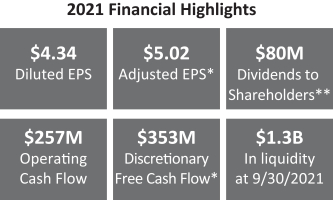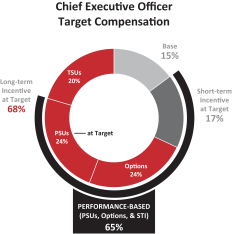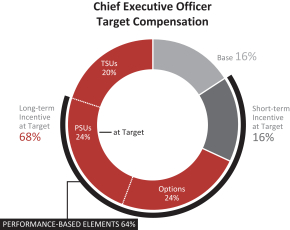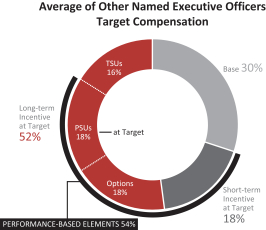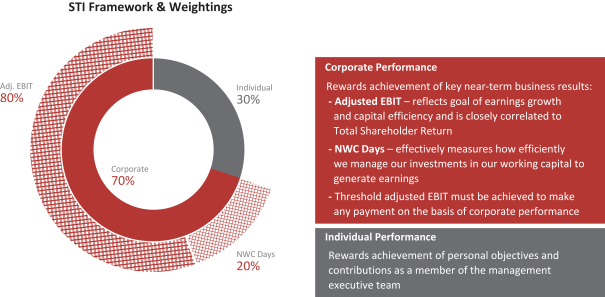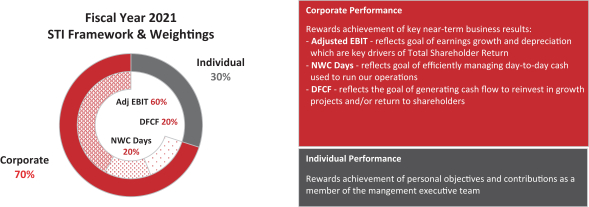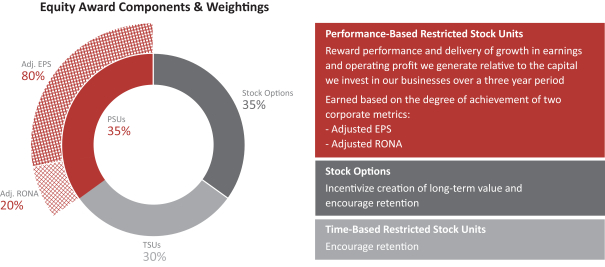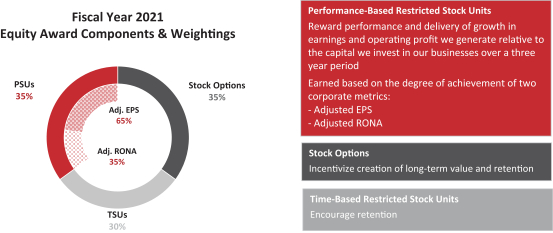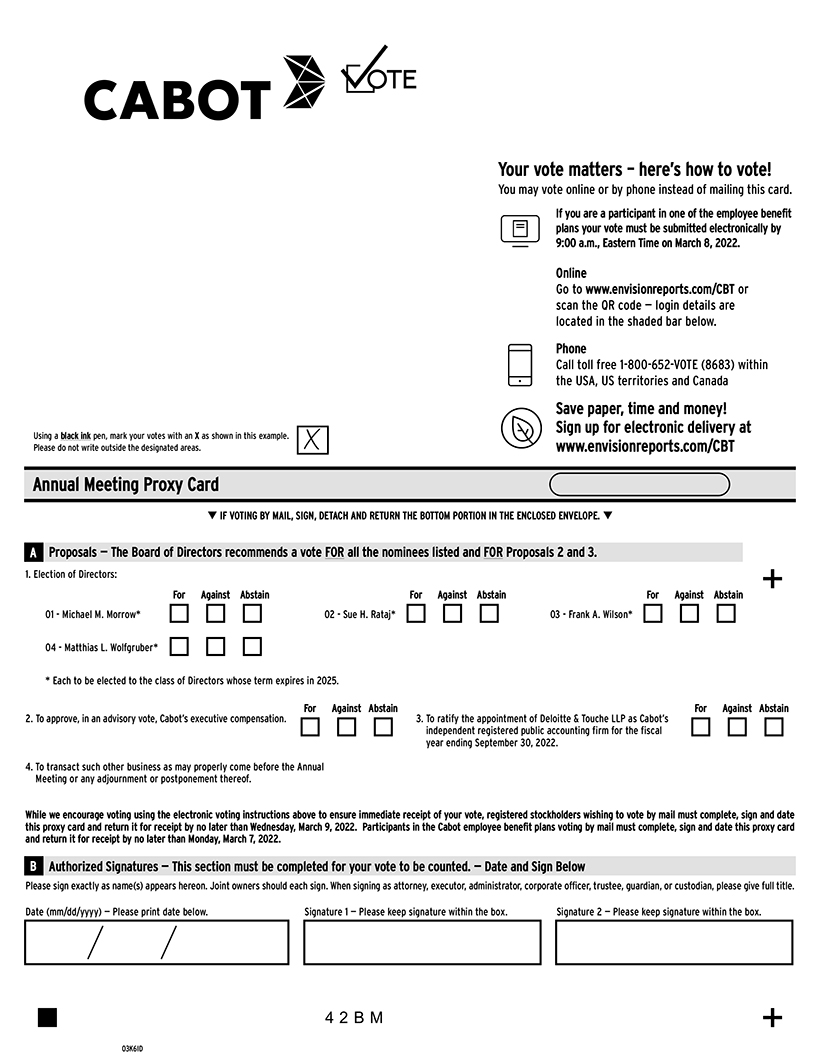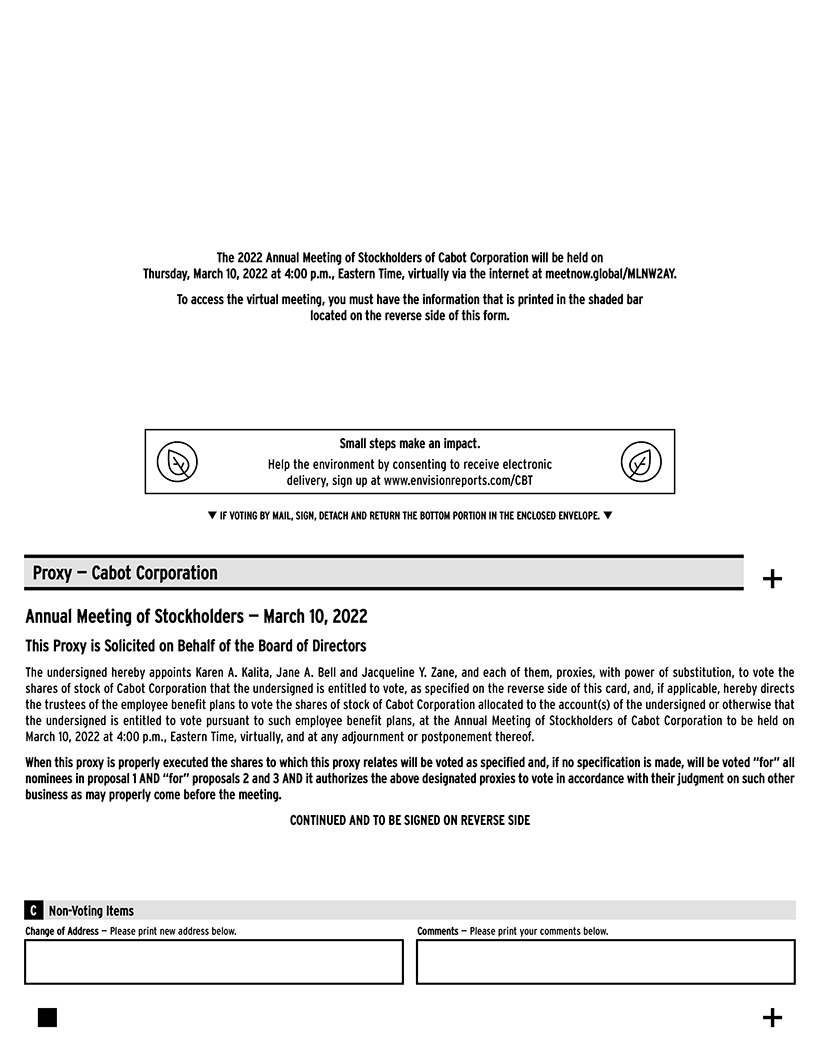Director Compensation
Annual compensation for ournon-employee directors is comprised of cash compensation and a grant of Cabot common stock. The Governance Committee is responsible for reviewing the form and amount of compensation paid to ournon-employee directors and recommends changes to our Board of Directors as appropriate. TheIn November 2021, the Governance Committee, regularly reviews competitive market data with the assistance of Mercer LLC,Meridian, a national executive compensation firm, engaged by this Committee, to evaluate the reasonableness of our director compensation and the appropriate mix of cash and equity compensation. In November 2018, the Governance Committee evaluated the competitiveness of the Company’s director compensation program, which included a review of director compensation data prepared for the Governance Committee by Mercer usingfrom the same peer group of companies our Compensation Committee uses for assessing the reasonableness of our executive compensation decisions. Based on this evaluation and upon the recommendation of the Governance Committee, our Board of Directors approved, effective January 1, 2019, an increase in the annual equity compensation component of this program and several2022, numerous changes to the cashour non-employee director compensation component of the program each as described below. Directors who are Cabot employees do not receive compensation for their services as directors.
Cash Compensation
In 2018,calendar year 2021, cash compensation for ournon-employee directors consisted of an annual retainer of $75,000, plus the following annual retainers for specific roles:components:
$16,000 for serving on the Audit Committee (plus another $25,00020,000 for serving as Chair of the Audit Committee).Committee
$7,000 for serving on each of the Compensation, SHE&S or Governance Committees (plus another $10,00015,000 for serving as Chair of the Compensation Committee
$10,000 for serving as Chair of the SHE&S orCommittee
$10,000 for serving as Chair of the Governance Committees).Committee, which was waived by the Committee Chair
$110,000 for serving asNon-Executive Chair of the Board of Directors.Directors
Effective January 1, 2022, annual cash compensation for our non-employee directors consists of the following components:
$20,000 for serving as Chair of the Audit Committee
$15,000 for serving as Chair of the Compensation Committee
$15,000 for serving as Chair of the SHE&S Committee
$15,000 for serving as Chair of the Governance & Nominating Committee
$120,000 for serving as Non-Executive Chair of the Board of Directors
Cash compensation is paid quarterly and, when changes occur in Board or Committee membership during a quarter, the compensation ispro-rated.
Effective January 1, 2019, we (i) increased the annual retainer from $75,000 to $90,000; (ii) eliminated the separate retainer for serving on a Committee; (iii) reduced the annual retainer paid to the Chair of the Audit Committee to $20,000; (iv) increased the annual retainer paid to the Chair of the Compensation Committee to $15,000; (v) retained the $10,000 cash retainer paid to the Chairs of the Governance and SHE&S Committees; and (vi) agreed to eliminate the cash retainer paid to the Chair of the Governance Committee when the Chair of that Committee is also serving asNon-Executive Chair of the Board. No change was made in the retainer paid to ourNon-Executive Chair of the Board.
Stock Compensation
Under the Cabot Corporation 2015 Directors’ Stock Compensation Plan (the “Directors’ Stock Plan”), eachnon-employee director is eligible to receive each calendar year shares of Cabot common stock as part of his or her compensation for services to be performed in that year. For calendar year 2018,2021, eachnon-employee director whose term of office continued after the 20182021 Annual Meeting of Stockholders received an award of shares having a grant date value as close as possible to $110,000 (1,636$120,000 (2,489 shares). Roderick C.G. MacLeod,Mark S. Wrighton, who retired atafter the 20182021 Annual Meeting, received apro-rated grant of 409622 shares. The closing price of our common stock on January 12, 2018,7, 2021, the date such shares were granted, was $67.24. Upon her election to the Board effective January 18, 2018, Dr. Arnold received a grant of 1,654 shares as compensation for her services as a non-employee director to be performed in$48.21. For calendar 2018. The closing price of our common stock on January 18, 2018 was $66.51. Upon his election to the Board on September 13, 2018, Mr. Wilson received apro-rated grant of 586 shares as compensation for his services as ayear 2022, each non-employee director to be performed in calendar 2018. The closing price of our common stock on September 13, 2018 was $62.61.
Following the review of the competitiveness of our director compensation program, and upon the recommendation of the Governance Committee, for calendar year 2019, we increased the annual equity compensation paid to ournon-employee directors toreceived an award of shares having a grant date value as close as possible to $120,000.$135,000 (2,254 shares).
As of January 15, 2019,18, 2022, there were 266,526194,291 shares available for issuance under the Directors’ Stock Plan.
CABOT CORPORATION 21
































